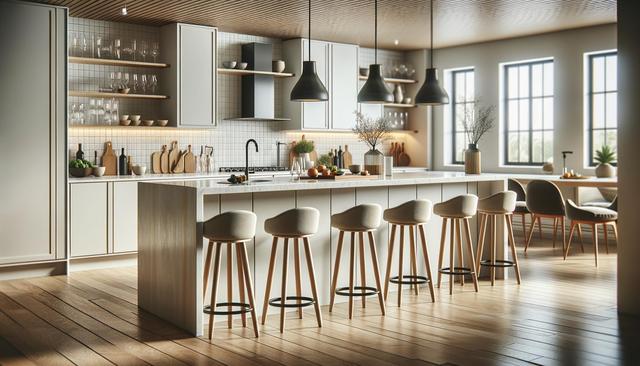Rethinking the Traditional Kitchen Island
Kitchen islands have long been a staple in home design, offering extra counter space and storage. However, for many homeowners—especially those working with smaller footprints or open floor plans—a traditional island may no longer be the most practical solution. Swapping your kitchen island for a bar table can offer a more flexible, space-savvy alternative. As modern kitchen design trends shift toward multi-functional and minimalist layouts, the bar table emerges as one of the most appealing kitchen island alternatives.
This change can help reduce visual clutter and enhance the flow of your kitchen. Instead of a bulky structure in the center of the room, a bar table opens up floor space, making the kitchen feel larger and more inviting. This is especially beneficial in open concept kitchen layouts, where maintaining a seamless connection between cooking and dining areas is key. A bar table can serve multiple purposes—prep station, dining area, and even a casual workspace—without dominating the room.
Maximizing Functionality in Small Kitchens
For compact spaces, maximizing every square inch is essential. Small kitchen renovation ideas often focus on improving functionality without sacrificing style, and a bar table fits perfectly into this strategy. Unlike traditional islands, which often require built-in cabinetry and electrical connections, bar tables are easier to install and more adaptable to changing needs.
Here’s how a bar table can enhance small kitchens:
- Provides a compact dining space for two to four people
- Creates a mobile or semi-permanent prep area
- Allows for better movement and less crowding
- Can be styled to match any design aesthetic
Choosing among the best bar tables for kitchens involves considering height, material, and storage features. Some models come with built-in shelving or drop-leaf panels, making them even more versatile. These space-saving benefits make a bar table one of the most practical kitchen island alternatives for smaller homes or apartments.
Blending Style with Practicality
One of the major advantages of swapping out a traditional island for a bar table is the opportunity to refresh your kitchen’s look. Modern kitchen design trends favor sleek, open, and airy aesthetics. A well-chosen bar table can introduce a touch of contemporary charm while still being highly functional. Materials like wood, metal, or glass can be selected to complement your existing décor, and bar stools offer another chance to personalize the space.
Unlike fixed islands, bar tables can also be updated or replaced more easily. This flexibility makes them an attractive option for homeowners who enjoy refreshing their interiors without committing to a full remodel. If you’re working with a limited budget, this can also align perfectly with affordable kitchen remodel tips that focus on high-impact changes without major construction.
Additionally, bar tables can help define space in open layouts without creating barriers. Positioned strategically, they can subtly separate the kitchen from the living or dining area while maintaining visual openness and continuity.
Creating a Social Hub in the Kitchen
The kitchen is often the heart of the home, a place where people gather to cook, eat, and socialize. A bar table enhances this dynamic by encouraging casual interaction and making it easier to connect with others as you prepare meals. Unlike a traditional island that may face a wall or appliances, bar tables typically promote more outward-facing setups, ideal for conversation and engagement.
Some ways a bar table can encourage more sociable kitchen experiences include:
- Serving as a casual buffet or drink station during gatherings
- Offering seating for guests or family to chat while you cook
- Doubling as a homework or work-from-home station
This versatility makes a bar table not just a design choice, but a lifestyle upgrade. It reflects a shift toward more open, interactive living spaces—one of the central themes in modern kitchen design trends today.
Choosing the Right Bar Table for Your Space
When deciding to replace your kitchen island with a bar table, it’s important to choose a piece that aligns with your layout and daily needs. Measurements are key—ensure there’s enough clearance around the table for easy movement and that its height suits your intended use. Counter-height and bar-height tables serve different functions, so consider how and when you’ll use the table most.
Here are a few factors to keep in mind:
- Dimensions: Leave at least 36 inches of clearance around the table
- Material: Choose durable, easy-to-clean surfaces like laminate, metal, or sealed wood
- Storage: Look for models with shelving or drawers for added utility
- Style: Match or contrast with your cabinetry and overall décor
For those looking to update their kitchens without a full renovation, bar tables offer a cost-effective solution. They fall in line with affordable kitchen remodel tips by delivering both style and function at a reasonable price point. Whether you’re aiming for an industrial vibe, rustic warmth, or a minimalist modern look, there’s a bar table to suit your vision.
Conclusion: A Simple Swap with Big Impact
Swapping your kitchen island for a bar table can be a game-changing decision, especially for those looking to streamline their space and embrace modern living. This simple change supports a more open, social, and flexible kitchen environment—perfect for entertaining, everyday meals, or just enjoying a morning coffee. As you explore kitchen island alternatives, consider how a bar table could align with your goals, whether you’re inspired by small kitchen renovation ideas or simply following modern kitchen design trends. With smart planning and thoughtful choices, this upgrade can bring new life to your kitchen without the need for a major overhaul.






